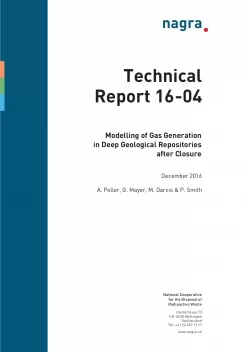
Technical Report NTB 16-04
Modelling of Gas Generation in Deep Geological Repositories after Closure
In deep geological repositories for radioactive waste, significant quantities of gases will be generated in the long term as a result of various processes, notably the anaerobic corrosion of metals and the degradation of organic materials. Therefore, the impact of gas production on post-closure safety of the repositories needs to be assessed as part of a safety case.
The present report provides a comprehensive description of the quantitative modelling of gas generation and associated water consumption during the post-closure phase of deep geological repositories in Opalinus Clay based on current scientific knowledge and on current preliminary repository designs. This includes a presentation of the modelling basis, namely the conceptual and mathematical models, the input data used, the computer tools developed, the relevant uncertainties and principal programme / design options, as well as the derivation, analysis and discussion of specific assessment cases.
The modelling is carried out separately for the two main sources of gas, which are the emplaced waste including the disposal containers; and the construction materials. The contribution of construc¬tion materials to gas generation rates in emplacement tunnels for spent fuel (SF) and vitrified high-level waste (HLW) is significant during several thousand years after closure. In the long term, however, the corrosion of the disposal canisters, which are in the reference case assumed to be fabricated of carbon steel, accounts for the vast majority of the total gas produced in these tunnels. The contribution of construction materials in emplacement caverns for longlived inter¬mediate-level waste (ILW) and low- and intermediate-level waste (L/ILW) to gas genera¬tion is generally small.
In ILW emplacement caverns, gas generation is generally dominated by hydrogen generation from the corrosion of cast iron Mosaik II waste containers for PWR internals and from the corrosion of aluminium in operational waste from the surface facility of the HLW repository. In L/ILW emplacement caverns, gas production is also generally dominated by hydrogen gener¬tion from the corrosion of carbon steel in decommissioning waste from the Beznau and Leibstadt reactors and from the PSI West research facilities, although the contribution of the latter is apparently less pronounced according to recently updated inventory data. For both ILW and L/ILW, the degradation of organic materials does not significantly affect gas production.
The main factors of influence are found to be the amounts and geometric properties of carbon steel and aluminium, the associated corrosion mechanisms and corrosion rates, as well as the environmental conditions that prevail during the respective time periods for safety assessment. Some of these factors will be addressed with future research activities in order to further reduce the existing uncertainties. In addition, a number of programme and design options have the potential to markedly reduce gas generation if needed: the melting of metallic ILW and L/ILW, the use of alternative disposal canisters with substantially lower gas production for SF and HLW, the removal and / or replacement of ILW and L/ILW waste containers prior to disposal, as well as the use of non-rail-based technology for waste emplacement and backfilling in SF/HLW emplacement tunnels.
